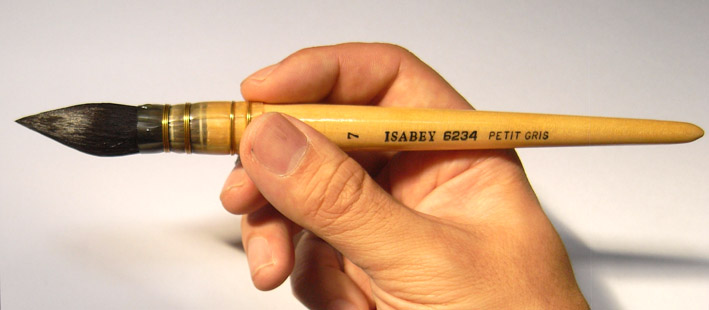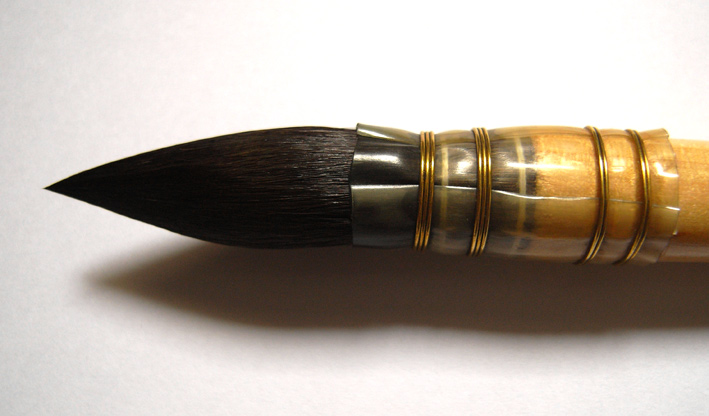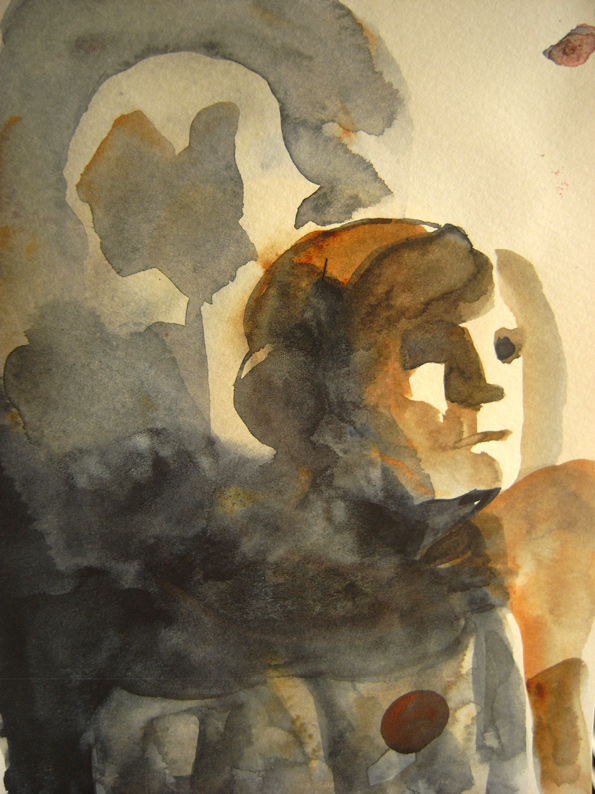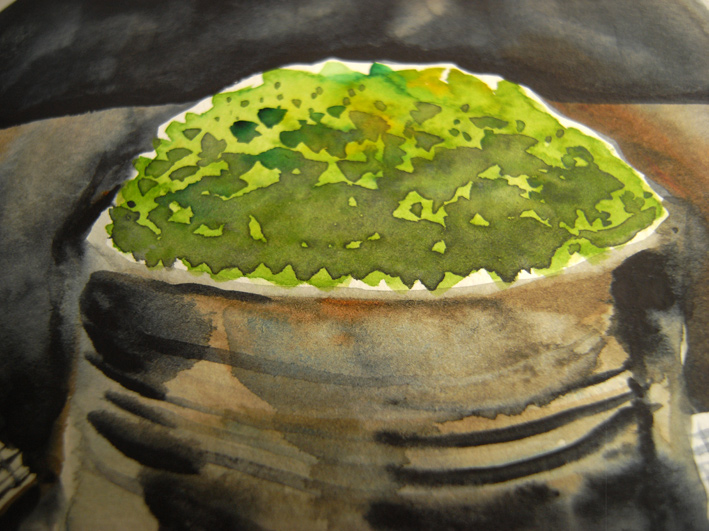Review: Isabey Siberian Blue Squirrel Quill Mop
First off, I must say that I'm not an expert when it comes to watercolour as some of you are. For washes, I usually use a waterbrush (with synthetic hair). For bigger washes, I sometimes use a #14 Colorpro sabeline brush or a big chinese calligraphy brush or a Japanese calligraphy brush. None of them exceeds US$25. I bought them only because they were big and they could cover big areas. I didn't really care what kind of hair they carried since I thought that so long as they could cover big areas with paint, it didn't make a difference. I've had some of these big brushes for years, but I seldom used them nor did I feel enjoyment when I used them.
My experience with the Isabey brand came about when I found a #4 Isabey 6729 Stradivarius martre sable brush at a fair. I tried it and I instantly loved the feel of it. It was more costly, but the feel of using it was better than my other sable haired brushes I owned. Since then it has become my favourite brush for line work when I do illustrations and comics.


When I did a search for other brushes by Isabey, I discovered the Isabey original siberian blue squirrel quill mop. I'd heard much about the wonders of squirrel hair brushes and was itching to finally own one. Also, since I felt I had not found a big brush that I really enjoyed using, I bought it hoping that this Isabey brush would overshadow my other big brushes just as my smaller Isabey brush overshadowed my small brushes. Furthermore, I did find a few very positive online reviews for this brush.

These mop brushes are from France. They are handmade and they look great (to me). I like how the hairs are tied together by brass wires onto a natural wood handle. They have character.
I bought the #7 since it fit my budget best and it looked big enough for the size of drawings I do. (I tend to draw small on A5 or A4 sheets). #7 is not the biggest brush in the series but it already costs US$75.77. That made it the most expensive brush in my possession!

The next step was to figure out how to use it since I'd never used a mop brush in my life. Anyways, here is my experience with the brush. I first washed it and dipped it in water until the hairs were fully soaked. I noticed that squirrel hair is indeed very very soft. The brush hairs felt like super soft moldable jelly (if you can imagine that). I also noticed that the hairs do not spring back when applied to paper. Instead, it retained whatever shape it was bent into very well.
This meant that I could not expect it to perform like a springy red sable brush. So, as the name suggested, I moved it around my paper like a floor mop. And that worked well! If you expect it to behave exactly like a red sable or even a sumi brush, you will be disappointed. It is a different kind of brush and you should give yourself time to appreciate its unique attributes.

With the brush fully wet, I dipped it into some paint and applied it on paper. With my first stroke, I noticed paint would come out strongly onto the paper, but with not much water. But by applying several more strokes, more water would cover the paper together with the paint. This seems to the the characteristic I heard regarding this squirrel hair mop brush – it absorbs water very well but it does not give out a lot of water with each stroke. This allows your watercolour pigments to show more strongly.

With this attribute, I felt that it allowed me to do wet-on-wet watercolour techniques without easily over-flooding my paper. I felt like I had more control over my paint and water as I added more layers of water and pigments onto my painting.
The feel of handling the brush was a delight. The way it pushed paint around my paper felt heavenly. Because of the softness of the squirrel hairs, the edges of each stroke applied were rather gentle making it great for blending and layering with watercolour on paper.


I managed to complete entire paintings with just this one brush. This is because the tip can be molded into a decently sharp point. And you can do a fair bit of detailed work with it. But ideally, I've heard it said that it would be best to use a thinner brush (eg. A kolinsky red sable) in combination with this mop brush. (I did the above painting with the mop brush + a finer red sable brush for the fine lines.)

I tried to do a comparison of 3 different brushes here. (It's not a perfect comparison. But it's the best I could do with what I had):
1) My big sabaline
2) My inexpensive big chinese calligraphy brush.
3) The Isabey mop brush.
I made sure all 3 brushes were soaked with water before dipping it ONCE in watercolour paint. (I did my best to ensure that they were dipped with the same pressure.) After that, I circled each brush 10 rounds each on paper.
Here is what I noticed:
1) Both the sabaline and chines brush created more streaks on paper after drying. The mop brush had less streaks due to the soft squirrel hairs. In fact, the mop brush's area had a nice smooth well-blended look, don't you think?
2) The mop brush's oval dried with a stronger color, which shows that it absorbed more paint from that one dip in pigment. I tried this a few times and the results were always the same.
All in all, I would gladly recommend this brush to anyone interested in adding a good big brush to their arsenal of brushes. Maybe “good” isn't enough for this brush. “Excellent” would probably suit it better. I love this brush! Apart from the above mentioned attributes, the feel of using the brush is also a delight. It makes me look forward to painting with watercolours more often.
Availability
Find more reviews at Dick Blick Art Materials (US) | Jackson's Art Supplies (UK)
Comments
Thanks for the interesting
Thanks for the interesting article. I used an Isabey mop brush today (size 5) and was pondering whether to invest in a larger one. You've helped me decide to go for it. I like the looseness and colour of your second watercolour painting above, too. :-)
I invested over a thousand
I invested over a thousand dollars in some of these brushes last year. I had been loving Isabey paint brushes all of my life until now. I bought all they had in the store and bought more online. First, I noticed that the hairs were coated with something that made them less willing to absorb the color. It felt really strange to have to keep dipping a brush that large into the vat. I hoped the hairs would roughen up over time. But far worse came as the wire popped open on the brush. First time use, and I had to re-wire the brush. Ok, anybody can have an off day of production, I thought, and loaded up the next brush. Again. Wire popped. Stop and re-wire. Ok, I have a drawer full of two-hundred dollar brushes rewired after the first use. They're misshapen at this point. I am sad my old faithful is no longer. So, I wrote the company I bought them from, Dick Blick. Blick informed me that production had moved from France to Africa and around the move, quality became an issue. I have a thousand dollars in it. Too late, Blick told me, I was past the return date. We know they're defective and sorry about your luck, from Blick. Get them old from yard sales, perhaps, but not new. They are no good.



Add new comment